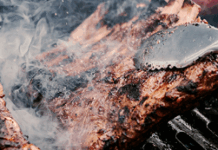Description: At about 1 ½-inches long, cicada killers are an intimidating wasp. They have
reddish colored wings and legs and a black abdomen with wide, yellow stripes. Cicada killers live independently though nests may be relatively close to each other. Females have a stinger which is used to paralyze their prey. They rarely sting people unless agitated. Males are smaller and do not have a stinger.
The female wasp is responsible for locating cicadas and paralyzing them with her
stinger. She then carries the cicada back to her burrow. Each burrow can house up to
20 cicadas.
Life Cycle: Adult females lay a single egg on each cicada they drag into the ground.
Eggs hatch in two to three days into legless, white grubs which feed on the cicada. The
larvae then create a protective case in which to overwinter. Adult wasps die in early fall.
In spring the larvae pupate in the pupal cases and emerge as adults in June/July. There
is one generation per year of cicada killers.
Damage: Cicada killers typically cause very little damage to the landscape. A heavy
infestation may become a nuisance as they protect their nests. The burrows may be
considered unsightly, especially in a lawn area.
Control: Cicada killers prefer well-drained, light soils in full sun. They may burrow along
sidewalks or flowerbeds but do not like areas covered with mulch. Maintaining a thick,
healthy lawn is the best control for preventing burrows. Pesticides are not usually
necessary since adults are only present for about two months beginning mid to late
summer.




